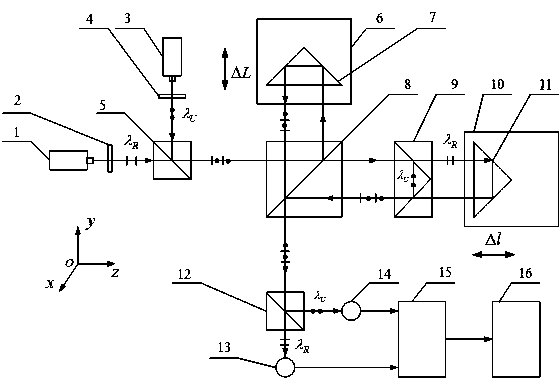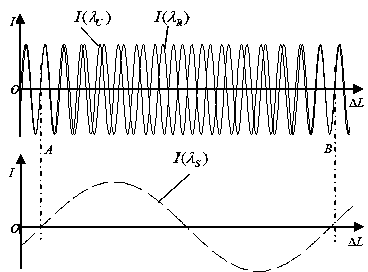Wavelength measurement method and device based on laser synthesized wavelength interference principle
A technology of laser synthesis and synthesis of wavelengths, which is applied in measuring devices, optical radiation measurement, and measuring optics. It can solve the problems of poor anti-interference ability of mechanical vibration, complex and invariable measurement system structure, etc., and achieve strong anti-environmental interference ability, Increased measurement range and high measurement accuracy
- Summary
- Abstract
- Description
- Claims
- Application Information
AI Technical Summary
Problems solved by technology
Method used
Image
Examples
Embodiment Construction
[0023] The present invention will be further described below in conjunction with the accompanying drawings and embodiments.
[0024] A wavelength measurement method and device based on the principle of laser synthesis wavelength interference, such as figure 1 As shown, the beam output by the reference laser 1 passes through the first polarizer 2 whose transmission direction is parallel to the y-axis, and then becomes linearly polarized light λ parallel to the y-axis R , to the first polarizing beam splitter 5; the light beam output by the laser to be measured 3 passes through the second polarizer 4 whose transmission direction is parallel to the x-axis, and becomes linearly polarized light λ parallel to the x-axis U , to the first polarizing beam splitter 5; linearly polarized light λ R Through the first polarizing beam splitter 5 and the linearly polarized light λ U After being reflected by the first polarizing beam splitter 5, a bundle of orthogonal linearly polarized ligh...
PUM
 Login to View More
Login to View More Abstract
Description
Claims
Application Information
 Login to View More
Login to View More - R&D
- Intellectual Property
- Life Sciences
- Materials
- Tech Scout
- Unparalleled Data Quality
- Higher Quality Content
- 60% Fewer Hallucinations
Browse by: Latest US Patents, China's latest patents, Technical Efficacy Thesaurus, Application Domain, Technology Topic, Popular Technical Reports.
© 2025 PatSnap. All rights reserved.Legal|Privacy policy|Modern Slavery Act Transparency Statement|Sitemap|About US| Contact US: help@patsnap.com



